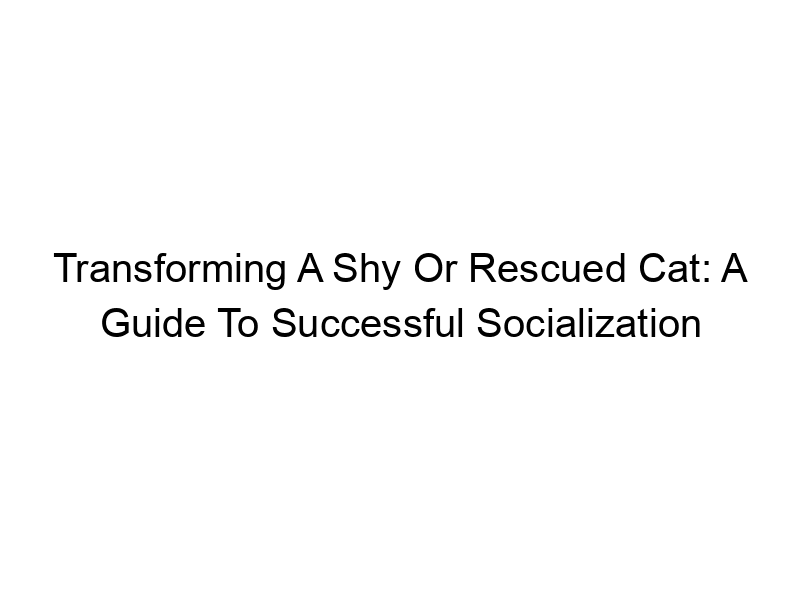Bringing a shy or rescued cat into your home is a rewarding experience, but it requires patience, understanding, and a dedicated approach to socialization. How to Socialize a Shy or Rescued Cat can feel overwhelming at first, but with the right techniques and consistent effort, you can help your feline friend blossom into a confident and loving companion. This comprehensive guide will walk you through the process, from understanding your cat’s behavior to building a strong bond. We’ll cover everything from creating a safe space to engaging in positive reinforcement and addressing potential challenges along the way. Let’s begin!
Before you begin the socialization process, it’s crucial to understand your cat’s unique personality and history. A cat’s past experiences, whether they involve neglect, abuse, or simply a lack of
socialization, significantly impact their behavior. Observe your cat’s body language. Do they flinch at sudden movements? Do they avoid eye contact? Do they hiss or growl? These cues provide valuable insights into their comfort levels and anxieties. A veterinarian can also offer valuable insights into your cat’s overall health and any underlying medical conditions that might contribute to shyness.
Creating a Safe and Secure Environment
Establishing a Safe Space
Every shy cat needs a sanctuary – a quiet, secure space where they can retreat when feeling overwhelmed. This could be a cat tree, a comfy bed in a quiet room, or even a cat condo. Ensure this space is easily accessible and stocked with food, water, litter box, and comfortable bedding. Make it a place they feel completely safe.
Minimizing Stressors
Reducing stress is paramount. Avoid sudden loud noises, overly enthusiastic greetings, or forcing interactions. Keep your home relatively calm, especially during the initial adjustment period. If you have other pets, introduce them gradually and supervise all interactions carefully. A pheromone diffuser (Feliway) can help create a more calming atmosphere.
Gradual Introduction to Your Home and Family
The Power of Patience
Socialization isn’t a race; it’s a marathon. Allow your cat to adjust to their new surroundings at their own pace. Don’t rush the process. Spend time near their safe space, talking softly and offering treats. Let them approach you on their own terms. Resist the urge to force interactions.
Positive Reinforcement Techniques
Positive reinforcement is key. Reward any positive behaviors, such as approaching you, allowing you to pet them, or engaging in play, with treats, praise, or gentle petting. Avoid punishment, as this will only increase fear and anxiety. Small, frequent, positive interactions are far more effective than infrequent, intense ones. Use high-value treats that your cat absolutely loves.
Interactive Play and Engagement
Choosing the Right Toys
Interactive play is an excellent way to build trust and bond with your cat. Choose toys that engage their natural hunting instincts – feather wands, toy mice, or laser pointers (used responsibly, never directly shining in their eyes). Keep play sessions short and fun, ending before your cat becomes overstimulated or frustrated.
Building Confidence Through Play
Play helps build confidence by allowing your cat to express their natural predatory behaviors in a safe and controlled environment. It also provides physical and mental stimulation, which can help reduce anxiety and stress. Remember to vary your play techniques to keep your cat engaged and entertained.
Understanding Feline Body Language
Decoding Your Cat’s Signals
Learning to interpret your cat’s body language is essential for successful socialization. A relaxed cat will have relaxed ears, a slow blink, and a soft tail. Signs of fear or stress include flattened ears, dilated pupils, a tucked tail, hissing, growling, or swatting. Respect your cat’s boundaries and avoid approaching them if they are exhibiting signs of stress.
Responding Appropriately to Your Cat’s Signals
If your cat displays signs of fear or stress, back off immediately. Give them space and time to calm down. Approaching a stressed cat can worsen the situation. It’s crucial to respond sensitively to their cues. If they hiss, don’t push it. If they run to their safe space, allow them to be there. Consistency in understanding and responding is essential.
Introducing Your Cat to Other Pets
Gradual and Supervised Introductions
Introducing your shy cat to other pets requires patience and careful planning. Start by allowing them to smell each other under the door, gradually increasing exposure until they can interact briefly, under close supervision. Never leave them unsupervised during initial meetings. Positive reinforcement for calm behavior can encourage a positive relationship.
Managing Potential Conflicts
Conflicts can arise, even with slow introductions. Have separate feeding and resting areas, and offer lots of enrichment (toys, climbing structures) to minimise competition. If aggression occurs, separate the animals immediately, and consult with a veterinarian or animal behaviorist for guidance. It’s okay to keep them separate if they aren’t getting along. Never force interaction.
Seeking Professional Help
When to Consult a Veterinarian
If your cat’s shyness is extreme or accompanied by other concerning behaviors (excessive hiding, lack of appetite, self-mutilation), it’s crucial to consult a veterinarian to rule out any underlying medical conditions. Some medical conditions can manifest as behavioral problems.
Working with a Certified Cat Behaviorist
A certified cat behaviorist can provide tailored guidance and support based on your cat’s specific needs and history. They can help you develop a personalized socialization plan and address any challenges you may encounter. They are trained in behavior modification and have valuable expertise in dealing with shy or fearful cats. Look for a certified member of a professional organization.
Utilizing Environmental Enrichment
Creating a Stimulating Environment
Environmental enrichment can significantly contribute to a cat’s well-being and reduce stress. Provide plenty of climbing opportunities, scratching posts, toys, and hiding places. Rotate toys regularly to maintain interest and prevent boredom.
The Importance of Vertical Space
Cats are naturally arboreal creatures and appreciate vertical space. Cat trees, shelves, and window perches provide elevated vantage points, allowing your cat to feel safe and observe their surroundings without feeling vulnerable.
Overcoming Common Challenges
Dealing with Fear and Anxiety
Persistent fear and anxiety can significantly hinder the socialization process. Techniques like desensitization and counter-conditioning can help. Desensitization involves gradually exposing your cat to fear-inducing stimuli at a distance and intensity that doesn’t trigger fear. Counter-conditioning pairs the feared stimuli with positive experiences, like treats.
Managing Aggression
Aggression in shy cats is usually a manifestation of fear. Never punish aggressive behavior. Instead, focus on creating a safe and predictable environment, addressing any underlying stressors, and utilizing positive reinforcement techniques to reward calm and appropriate behavior. Consult a behaviorist for guidance.
Long-Term Socialization Strategies
Maintaining a Consistent Routine
Consistency is crucial in maintaining your cat’s progress. Maintain a regular feeding schedule, provide consistent opportunities for play and interaction, and continue to create a calm and predictable environment. A stable routine contributes to their sense of security.
Ongoing Positive Interactions
Socialization is an ongoing process. Continue to engage with your cat, build on your bond, and reward positive behaviors. Remember that progress may be gradual, but consistent effort will yield rewarding results.
The Benefits of Socialized Cats
Improved Physical and Mental Health
Well-socialized cats tend to have better overall physical and mental health. They are less prone to stress-related illnesses and behavioral problems. They’re more likely to live longer and happier lives.
Stronger Bond with Their Owners
A socialized cat forms a stronger bond with its owner, leading to a more fulfilling and rewarding companionship. This bond is built on trust, mutual respect, and consistent positive interactions.
Tools and Resources for Socialization
Recommended Cat Toys and Enrichment Products
Several brands offer interactive toys, scratching posts, and enrichment products designed to stimulate cats and improve their well-being. Research and choose products that suit your cat’s preferences and play style. Experiment to find what your cat loves most.
Online Communities and Support Groups
Connecting with other cat owners, especially those who have experience with shy or rescued cats, can provide invaluable support and practical tips. Online forums and support groups offer opportunities to share experiences, ask questions, and learn from others’ successes and challenges.
Frequently Asked Questions
What is the average time it takes to socialize a shy or rescued cat?
There’s no set timeframe. It depends entirely on the cat’s history, personality, and the consistency of your efforts. Some cats may adapt quickly, while others may require months or even years of patient work.
My cat hisses at me. Should I be worried?
Hissing is a warning sign. It means your cat feels threatened or uncomfortable. Respect their space and give them time to calm down. Don’t push for interaction. Consult a vet or behaviorist if hissing persists.
How do I know if my cat is comfortable with me?
Signs of comfort include slow blinks (a cat’s version of a smile), purring, rubbing against you, tail held high, and approaching you willingly. If they avoid eye contact, flatten their ears, or tuck their tail, they’re likely feeling uncomfortable.
Is it okay to use treats to train my shy cat?
Absolutely! Treats are a powerful tool for positive reinforcement. Use high-value treats that your cat loves to reward desired behaviors.
My cat hides all the time. Is this normal?
Hiding can be normal for a shy or rescued cat, especially initially. Provide a safe, quiet space where they feel secure. Gradually introduce them to more of your home over time.
Should I force my cat to interact with me or other pets?
Never force interaction. Forcing interactions will only increase fear and anxiety. Let your cat approach you and other pets on their own terms. Patience is key.
Final Thoughts
Socializing a shy or rescued cat is a journey that demands patience, understanding, and unwavering dedication. By creating a safe and stimulating environment, employing positive reinforcement techniques, and respecting your cat’s boundaries, you can help transform your feline friend into a confident and loving companion. Remember, progress may be gradual, and setbacks are possible, but with consistent effort and the right approach, you can witness a remarkable transformation. Don’t hesitate to seek professional help if needed. The bond you’ll build with your once-shy cat will be incredibly rewarding. Remember, every cat deserves a chance to thrive.




